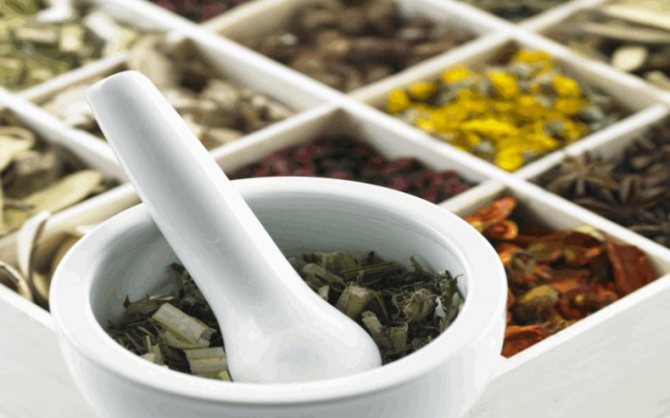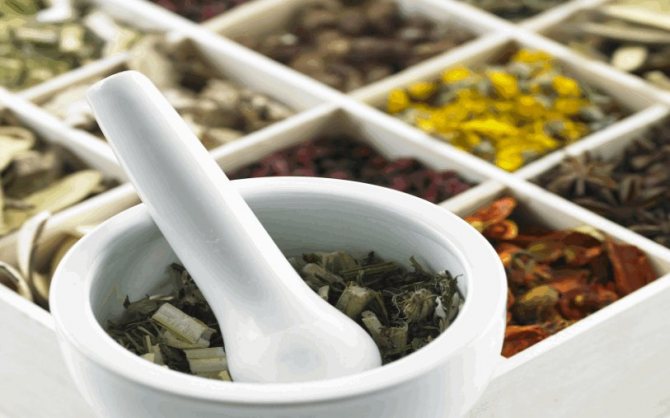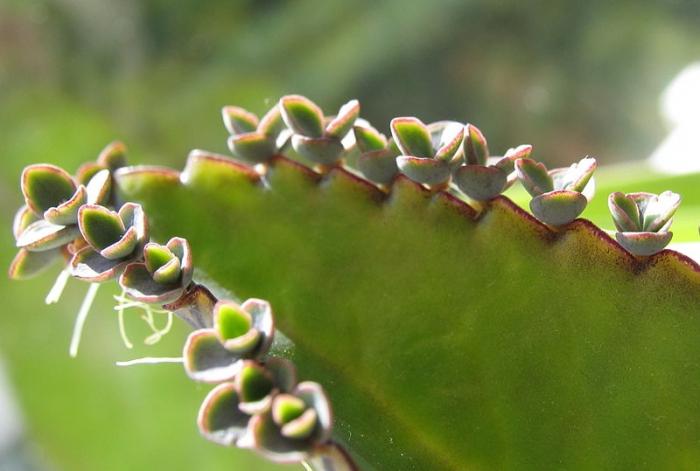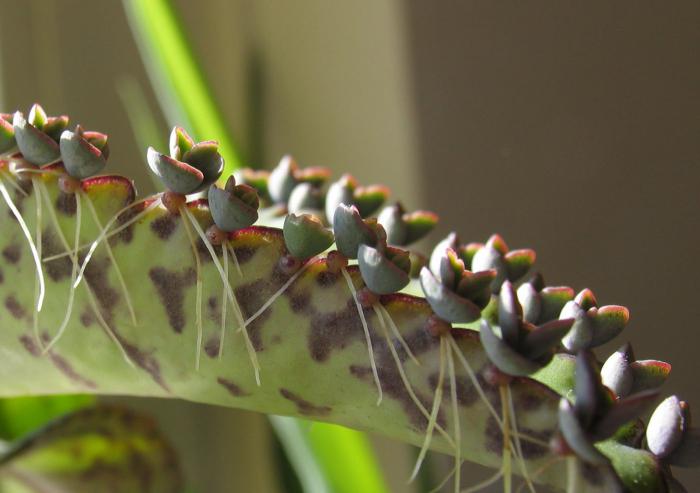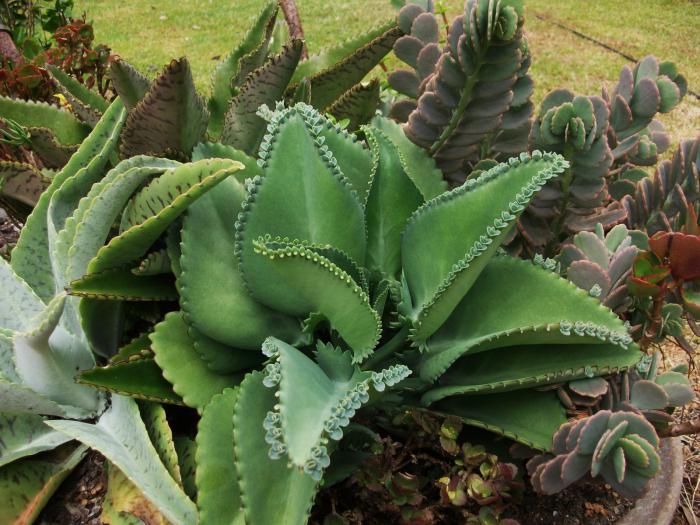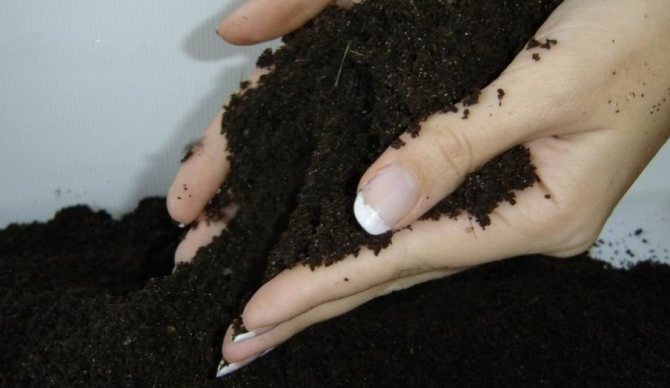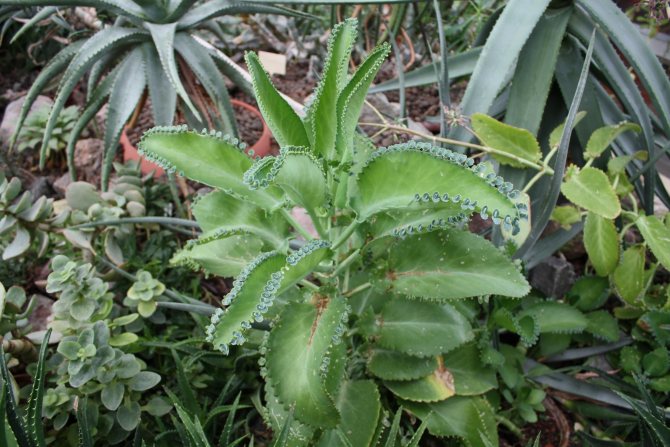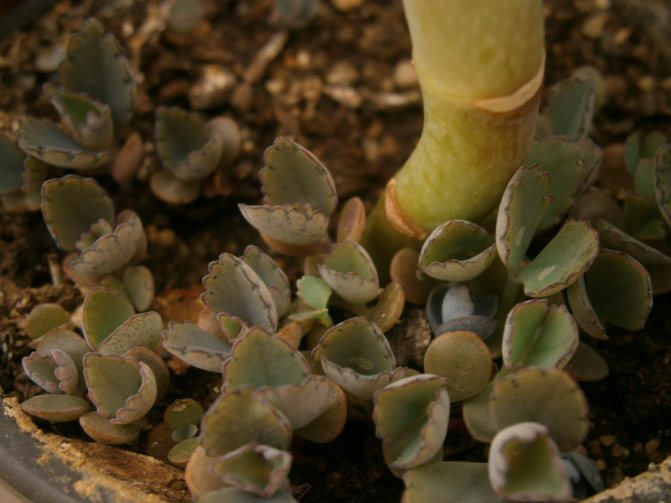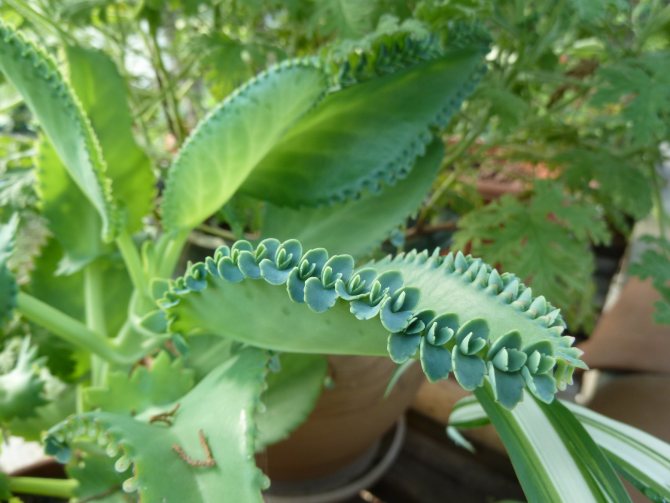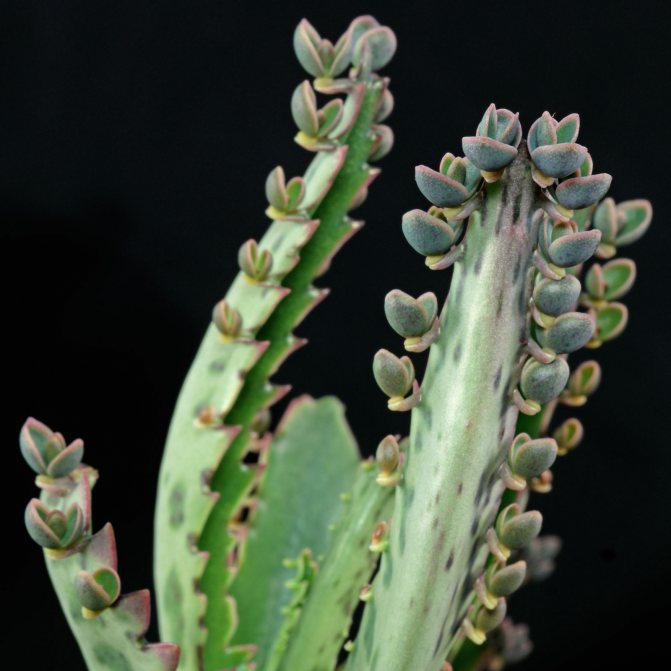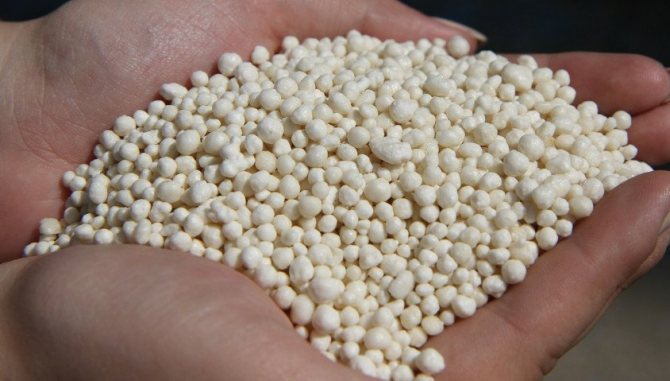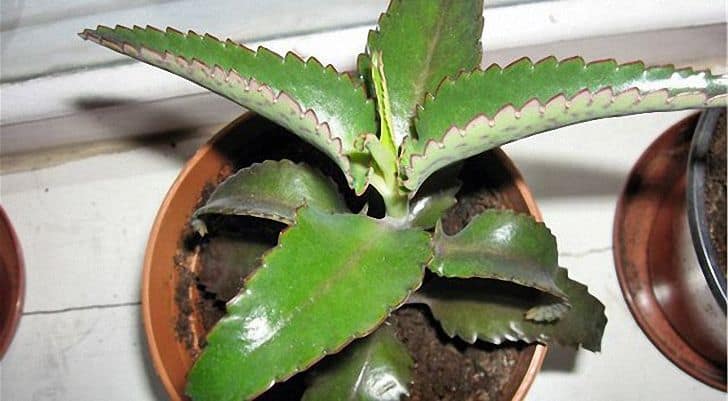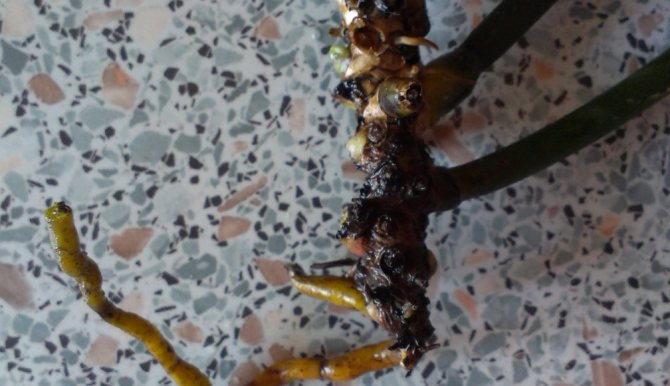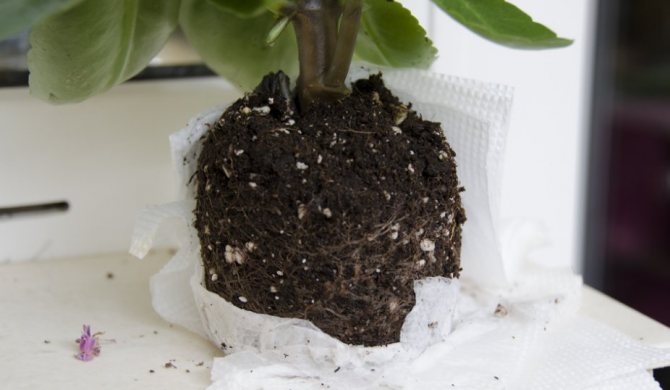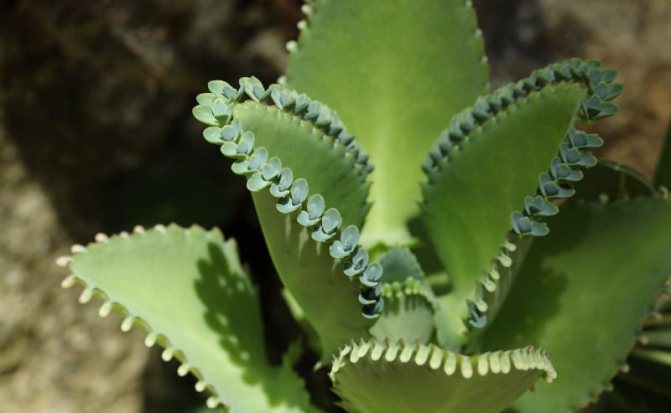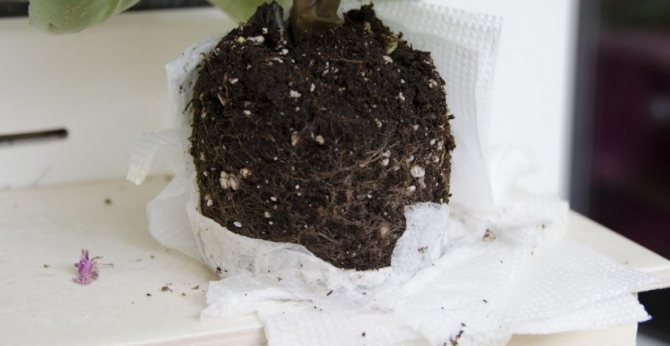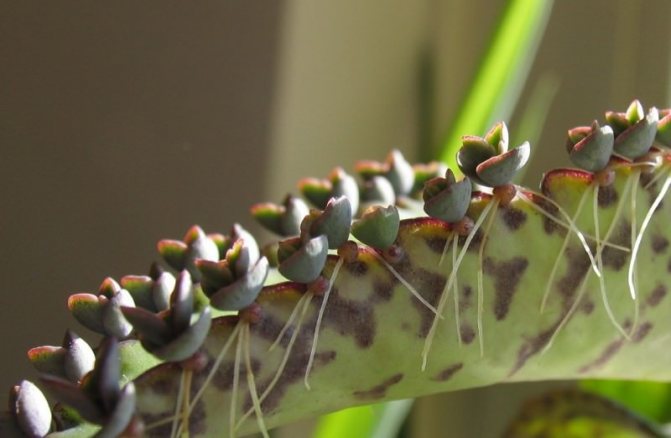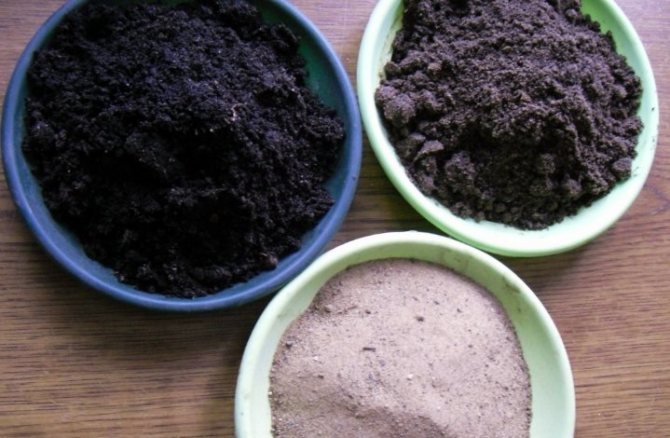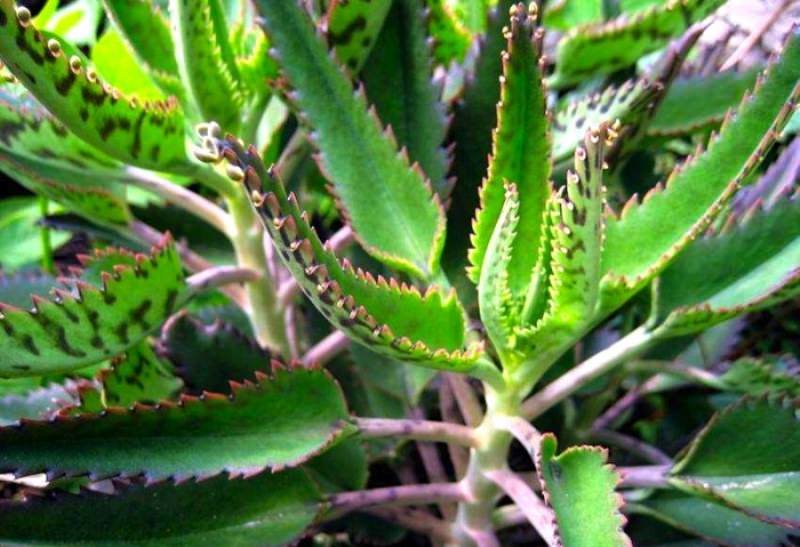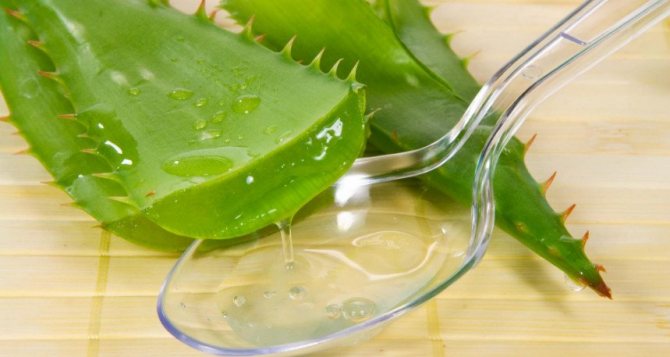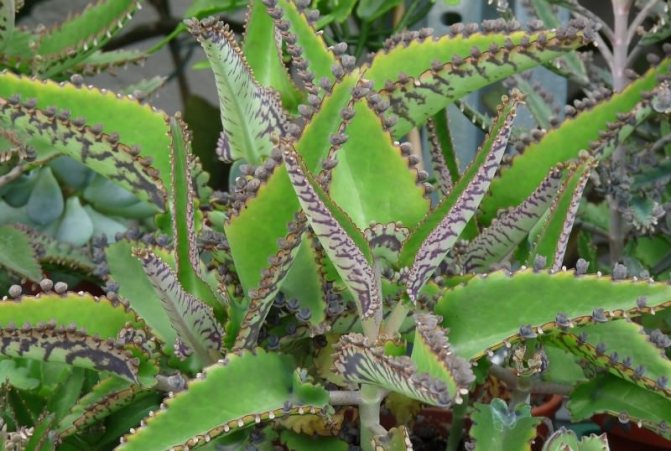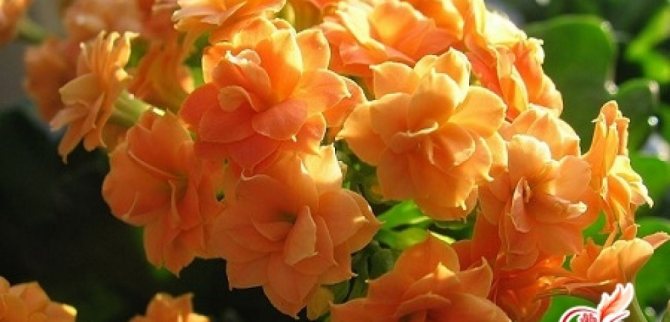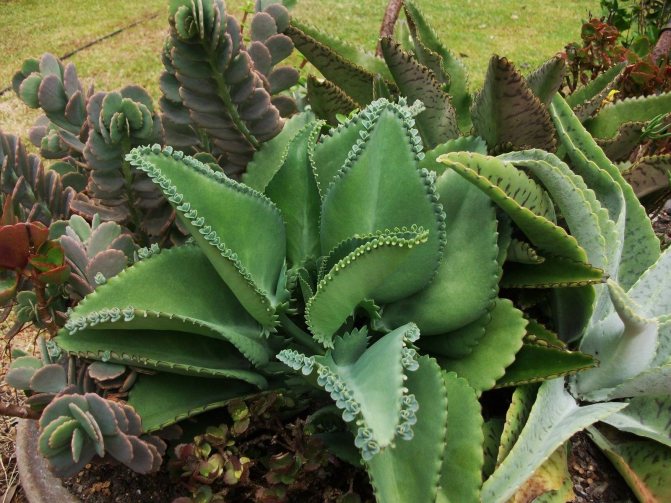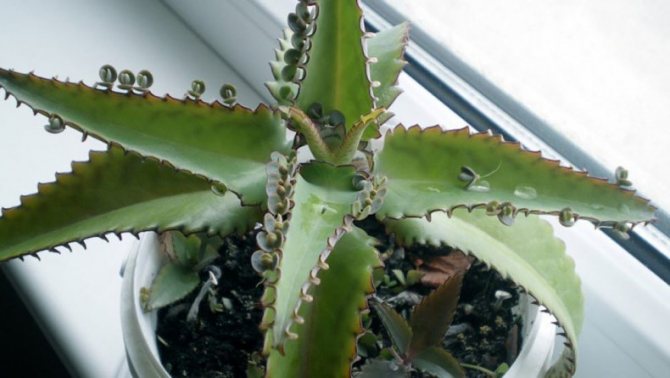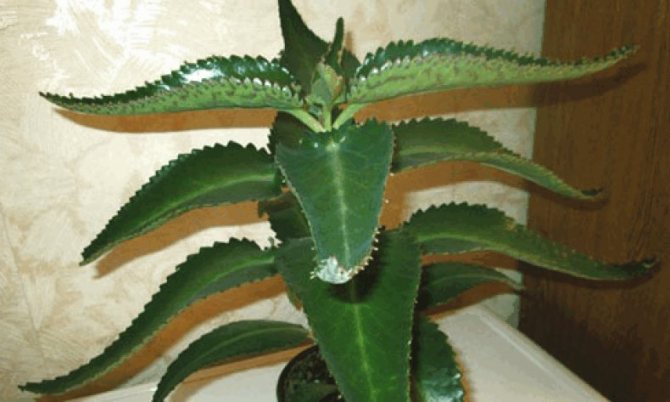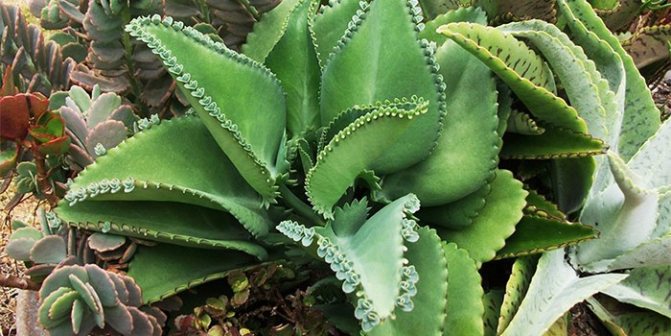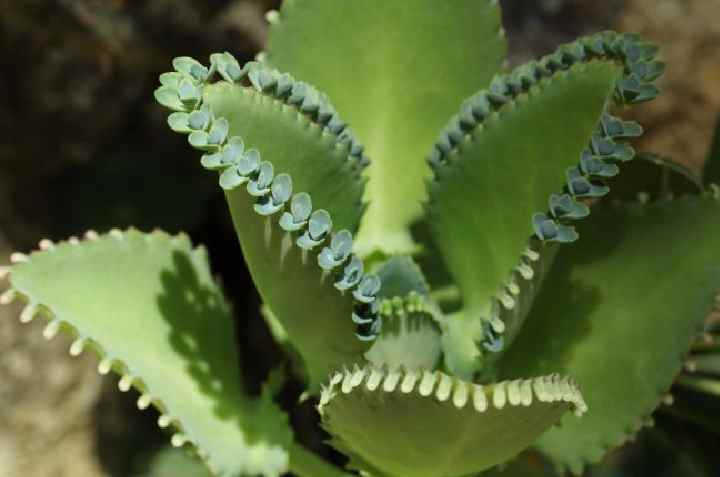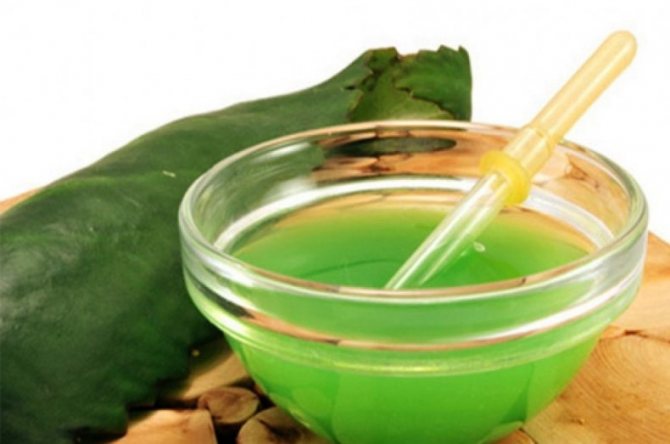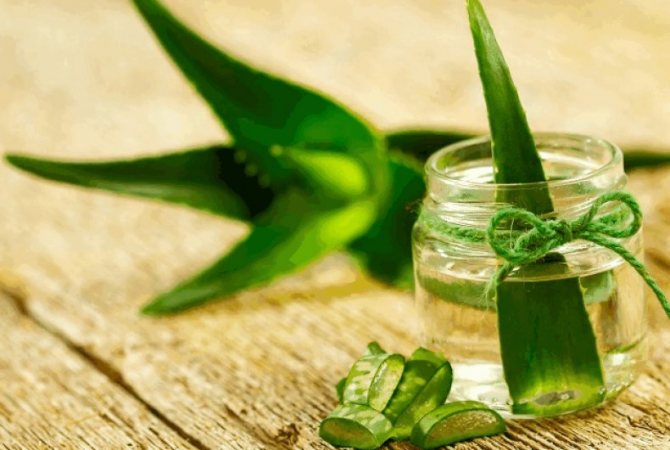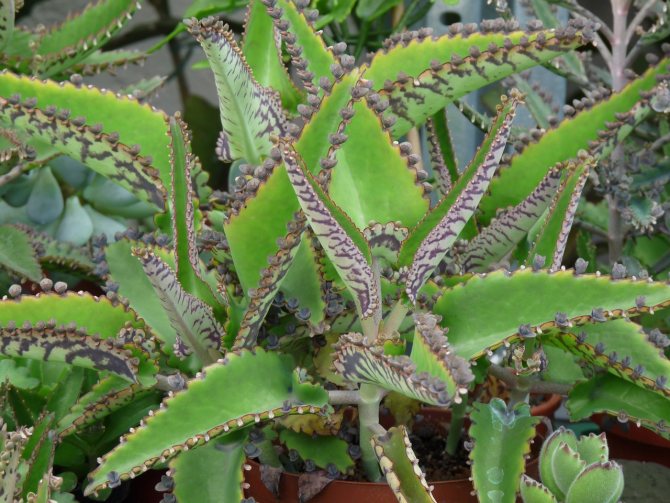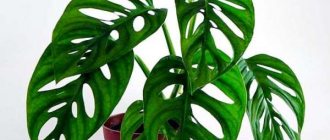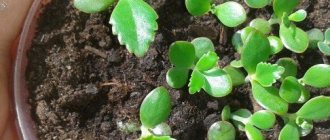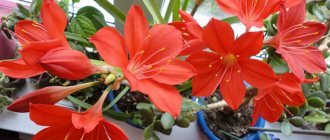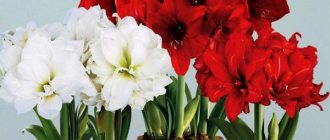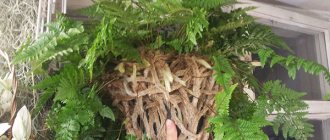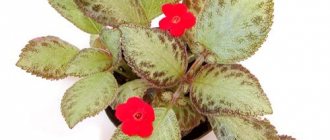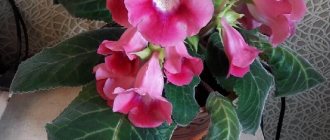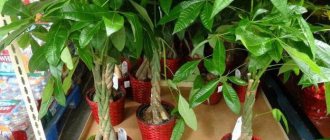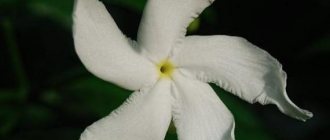The birthplace of the Kalanchoe Degremon is Madagascar. This is a herbaceous plant that can reach a height of up to half a meter. The leaves of this species are variegated from top to bottom and have a gray-green color. Their shape is elongated elliptical. Each leaf is strewn with spots of a purple hue. Inflorescences in this variety are panicles. The corolla tube can be up to 1.5 centimeters long. The petals are usually pink. Their length is on average up to 5 millimeters. Kalanchoe Degremona blooms usually in winter.
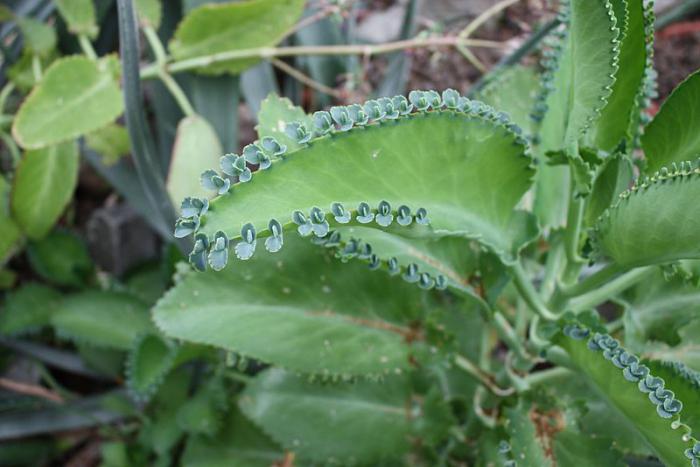
Origin and botanical description of the plant
Kalanchoe Degremona arrived in the temperate zone in the last century from South Africa, Asia and America. This perennial plant belongs to the genus succulents, the jasper family. The leaves are fleshy, elongated with a pointed end and uneven edges. The color of the plates is dusty green. The skin is smooth, without roughness and velvety effect.
Kalanchoe blooms pink or red, most often in winter. The flowers are like large bells. At home, this is quite a rare occurrence. Flowering lasts from 1 to 2 months, depending on the conditions of maintenance and care.
This species quickly gained popularity due to its medicinal properties. Most often, the pulp of the leaves and the juice of this plant are used for:
- Treating the common cold.
- Respiratory tract disease prevention.
- Burn treatment.
- Healing of small cuts and open wounds.
- Treatment of trophic ulcers.
Kalanchoe paniculata (Kalanchoe thyrsiflora)
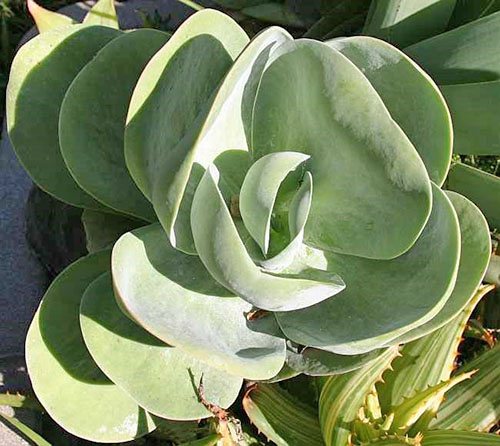

The herbaceous perennial, whose stems grow up to 60 centimeters long, comes from the rocky regions of South Africa. Stems are erect, practically not branching, are planted with obovate leaves, tapering towards the petiole. Fleshy, dense leaves are green in color, sometimes a red or crimson border forms along the edge. The leaf plates of the lower leaves are much larger than the upper, young ones.
At the top of the shoot, in spring, a paniculate elongated inflorescence is formed, uniting yellow flowers 1.5 cm in diameter. After flowering, numerous daughter rosettes appear on the Kalanchoe, rooting well and giving the next generation of plants.
Necessary conditions for growing
Kalanchoe Degremona is an unpretentious variety that can grow in Spartan conditions. In order to preserve the maximum amount of useful properties of this plant, it is necessary to fertilize it well, water it on time and follow other rules of care and maintenance.
Location and lighting
Kalanchoe needs a lighted place for growth and development. This representative of exotic fauna feels most comfortable in the south or southeast of the apartment. In summer, the leaves need partial shade, because with abundant lighting they do not have time to produce the required amount of nutrients.
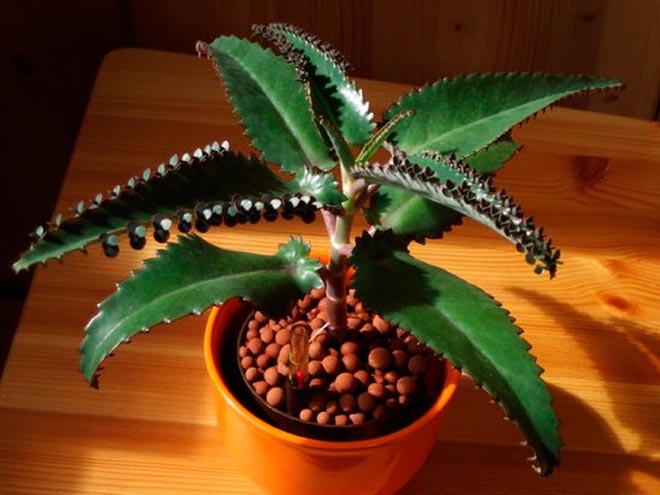

Direct sunlight is destructive for the Kalanchoe. To protect the plant from burns, it is best not to put it on the windowsill.
Air humidity and temperature
The requirements for the microclimate of the Kalanchoe differ depending on the flowering or dormancy period. This plant does not fully hibernate, and this fact must also be taken into account.
The temperature and humidity in summer should resemble the subtropics native to the flower as much as possible. The general indicator of the mercury column during the day should not fall below 25-27 degrees.To maintain the required moisture level, the leaves are sprayed from a spray bottle once every 2 days.
In winter, the Kalanchoe blooms, and does not hibernate, therefore it also needs high temperatures. The lower limit for this exotic plant is 15 degrees.
For comfortable flowering, it is better to maintain the mercury column in the region of 18-22. Spraying is carried out not every morning, but once every 4-5 days.
Requirements for soil and pot
The soil for growing Kalanchoe needs prepared, or purchased in a specialized store. The composition of the soil includes:
- Deciduous land (2 parts).
- Sod land (2 parts).
- Peat (2 parts)
- Coarse river sand (3 parts).
The main requirements for the soil:
- Low acidity.
- Loose soil.
- Good moisture permeability.
- Lightness and stability.
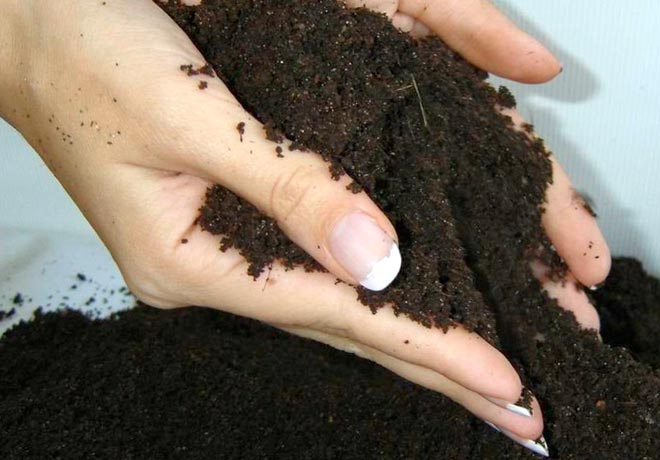

Kalanchoe marble (Kalanchoe marmorata)
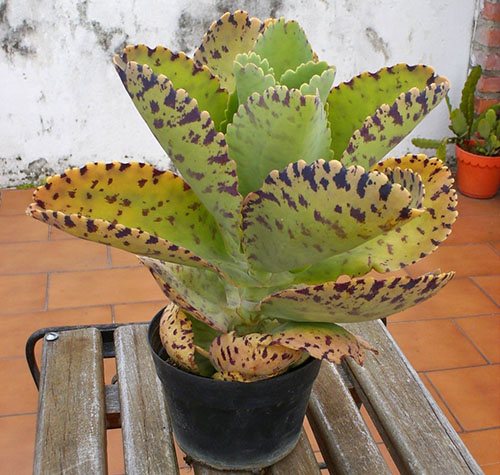

Kalanchoe marble or variegated can be seen in the mountainous regions of Ethiopia, and a half-meter, strong shrub with large obovate leaves feels best not in the valleys, but at an altitude of 1,500 to 2,500 thousand meters, where periods of drought and coolness are frequent.
The leaves have a rounded-toothed edge and the color that gave the name to the entire plant. Leaf plates of a greenish-brown hue are covered with large purple or brown specks, which mask the plant well against the background of clay soil and stones.
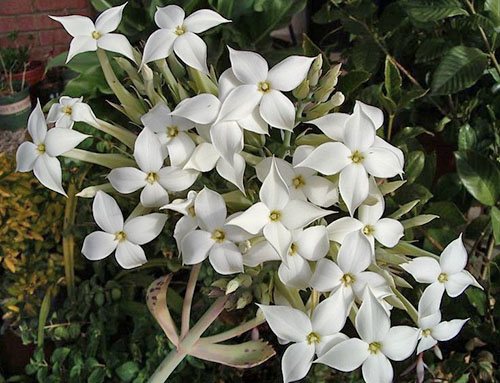

The inflorescence of the marble Kalanchoe has the shape of an umbrella and consists of graceful white flowers with four pointed petals and an elongated tube up to 7 cm long.
Care features
Caring for the Kalanchoe Degremon at home will not take much time even for an experienced gardener. This plant is quite unpretentious, watered and fertilized according to a strictly worked out scheme. The easiest way is to take care of this representative of exotic flora by compiling your own instructions, taking into account the microclimate of the apartment.
The need for watering
Degremona is a succulent, therefore, it is often not necessary to water it, since the moisture necessary for life and development is concentrated in its leaves. In the hot season, watering is considered optimal once a week. In winter, the interval between soil irrigation increases to 2 weeks. In spring and autumn, watering is carried out taking into account the weather outside the window and the temperature in the house.
Excess moisture for Kalanchoe is fatal. The decay process begins at the slightest waterlogging, so this must be strictly monitored. The plant is watered with warm settled water, drinking or running.
Degremona does not need frequent fertilization. You can feed the Kalanchoe with fertilizers for succulents or special mixtures that are sold in stores for gardeners. The only difference is that in the first case, you need to use half of the fertilizer from the dose indicated on the package, and in the second, the instructions should be followed exactly.
Kalanchoe is fed in spring and summer 1 time in 2 weeks. In autumn, the interval between fertilizers increases to 3 weeks. In winter, you need to take a break from feeding, despite the fact that the plant is just starting to release buds. Immediately after the flowering period, the soil should be abundantly fertilized.
Plant formation
Degremona can be formed for both medicinal and aesthetic purposes. Pruning is carried out several times a year: in the fall, after the heat subsides, and immediately after all the flowers have fallen off. Also, a medical haircut is recommended to be carried out after purchase, so that weakened shoots do not interfere with the plant to take root in a new place.
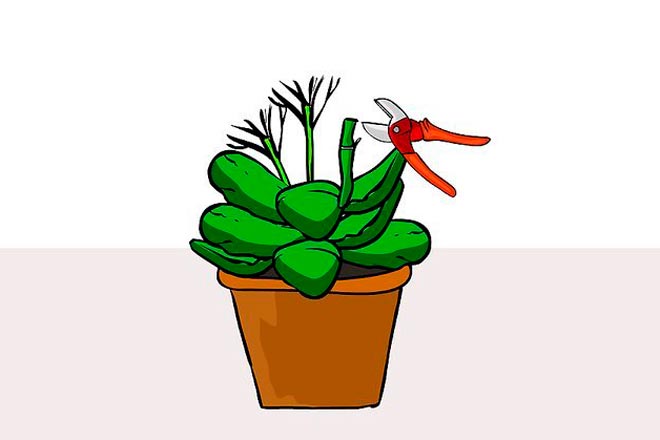

Young branches should be pruned carefully, removing only a few of the top leaves. This will accelerate the growth of the lower leaves, which can soon be used for medicinal purposes, as well as stimulate the development of the shoot itself.
Experienced gardeners recommend trimming and pinching Kalanchoe in the morning.The plant is actively developing until noon, so it will be able to quickly regenerate and experience less stress.
Pests and diseases
Kalanchoe, due to its medicinal properties, is immune to many diseases and pests. Most often, this plant is sick due to improper care. As a result, it stops blooming, and the skin of the leaves shrinks. Treatment is carried out by restoring the correct maintenance and care regimen.
In temperate climates, there are only two types of pests that can cause inconvenience to Degremon, namely aphids and scale insects.
It is best to fight these insects by treating the leaves and soil with insecticides. It is almost impossible to remove them with folk remedies. After treatment, the sheets cannot be used for medicinal purposes for the next 2 months.
Healing properties
Kalanchoe Degremona, along with Kalanchoe pinnate, is a medicinal representative of the Kalanchoe genus, with pronounced healing properties. Both of these types have the same medicinal properties:
- wound healing;
- hemostatic;
- anti-inflammatory;
- bactericidal
- anti-allergic;
- immunomodulatory.
The presence of brood buds distinguishes Degremon from the pinnate, which has no “children”. Another difference is that during the flowering period of Kalanchoe Degremona is considered poisonous and it is forbidden to take it inside.
The healing properties of Kalanchoe pinnate and Degremon have been recognized by official medicine and are used in pharmacology for the manufacture of medicines (mainly alcoholic tinctures).
The juice of this type of Kalanchoe, contained in the stems and leaves, has healing properties. Application in medicine has a fairly wide range - gynecology, ophthalmology, surgery, etc.
If you or your loved ones often suffer from colds, then be sure to put this plant in the room in which you spend a lot of time. It is able to defeat influenza viruses and other pathogenic microbes and microorganisms.
Kalanchoe Degremon juice is very often used in the treatment of rhinitis. One has only to drop it in and the disease quickly begins to recede.
For the preparation of tincture and juice, it is worth taking leaves that are located close to the base. The juice tastes bitter, with a slight sourness. You can store it for a long time - it does not deteriorate. It is very good to have pomace in stock, especially if there are small children in the house. This juice is good for treating wounds, cuts, abrasions, ulcers and burns, as it has excellent wound healing agents.
This flower is also known for its anti-inflammatory properties. It is very good to make compresses from it. The added raw egg white will enhance the effect of the juice.
Alcohol tincture
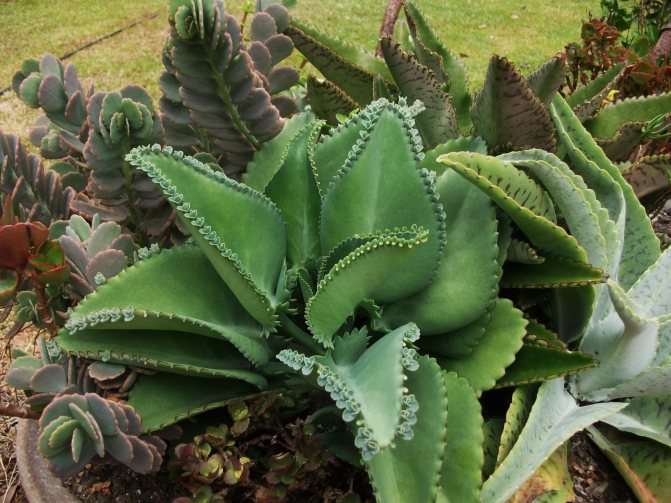

For the prevention and treatment of colds, alcohol tincture is often used. It is not difficult to make it: the cut leaves should be left in a dry and cool place for a week. After that, crush them into porridge and squeeze out the juice, which must be placed in the cold for another two days. After this time, mix the juice of Kalanchoe Degremon with alcohol (20% strength) in a ratio of 1:20. Keep refrigerated.
It is more convenient and more effective to use an ointment for treating wounds. It is very simple to prepare it: Grind the Kalanchoe leaves and squeeze the juice out of them, which we mix with lanolin or petroleum jelly in the proportion - 30 ml of juice per 50 grams of base.
Transplant timing and technology
Kalanchoe is a fast-growing plant, so it is transplanted quite often. During each move, the pot must be increased in diameter by at least 2-3 centimeters.
Until Degremona is five years old, she will need to be replanted every year. Thereafter, this procedure is carried out once every 2-3 years or less, depending on the growth rate of the plant.
During transplantation of Kalanchoe, you can easily damage its delicate and fragile root system.So that this does not happen, the earthen lump, which they hold, does not break or clean off from the rhizome. You just need to move the plant from a small pot to a larger one, slightly loosening the soil and adding a new substrate, and no more.
Read also: Zinnia: how to care for a flower at home
Kalanchoe shoots take root rather quickly - within 2 weeks for young plants and 1 week for older representatives of the species.
During transplantation, you need to remember about the drainage layer. It fits to the bottom of the pot and must be at least 3 centimeters thick. Small river pebbles are best suited for this role.
Diseases and pests: treatments
Kalanchoe Degremona is rarely infested with pests. But if this happens, then, most often, it is:
Rolling leaves, many small green insects, sticky coating on the stems and leaves of the plant are signs of infection. aphids... Spraying with insecticides will help get rid of the parasite.
Shield feeds on plant sap. It has a strong waxy shell, due to which insecticides practically do not act on the parasite. Therefore, it is necessary to manually remove the pests with a cotton swab dipped in alcohol. And only after that, apply an insecticide to spray the flower. It is better to change the soil in a pot to fresh.
Spider mite manifests itself as yellow dots on the leaves. A thin cobweb will be visible on the back of the leaves. In this case, insecticides will also help.
With a slight damage to the plant by pests, a single application of an insecticide is sufficient. If there was an abundant dispersal of parasites, then three times treatment with the drug may be required.
In addition to pests, Kalanchoe can damage mold (gray mold)... This is facilitated by a habitat that is too humid (over spraying, watering) in combination with stagnant air. At the same time, the leaves and stems are covered with weeping spots and a dark bloom. Treatment in this case is carried out with the help of fungicides, which are sprayed both on the plant itself and on the soil in the pot. It may be necessary to transplant a plant with the removal of damaged fragments of the root system.
Possible growing difficulties
Like all indoor plants, Kalanchoe has its own difficulties in growing, which you need to know about in order to enjoy its medicinal properties and appearance without unnecessary problems:
Kalanchoe is not only a beautiful, but also a fairly practical plant, the medicinal properties of which are appreciated all over the world. It is not at all difficult to grow a small "first aid kit" on your windowsill, you just need to be guided by simple care rules and create a microclimate suitable for the succulent.
Kalanchoe tubiflora (Kalanchoe tubiflora)
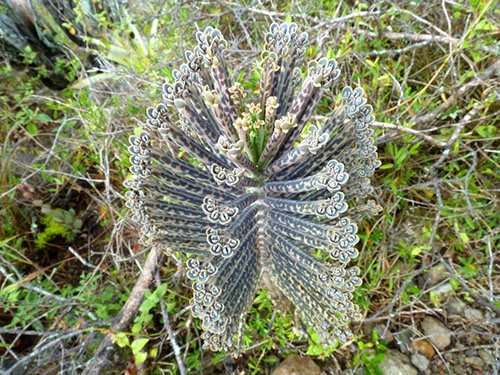

Like the Kalanchoe Degremona, in the photo the Kalanchoe is tube-colored, forms a lot of children on the leaves. This species also lives in the dry semi-deserts of Madagascar and forms strong bushes up to 70-80 cm high. Otherwise, these close relatives are difficult to compare.
Related article: Preparing balsam seeds
At first glance at the Kalanchoe tube-colored, narrow, up to 13 cm long leaves of a grayish-green hue draw attention to themselves. On a light background color, brown spots are clearly visible, giving the plant an even more unusual appearance. Flowers that appear on tall peduncles are elongated and burgundy-red in color.
Exotic on the windowsill: Kalanchoe Degremona
The originality of the Kalanchoe Degremon is not to be occupied - this representative of succulents instantly attracts the eye on the windowsill. The combination of bluish-green foliage of a pointed shape and "frills" of small children makes the plant one of the most unusual plants that can live in an apartment.
In addition to the exotic type of Kalanchoe, Degremona has a huge list of useful properties, and its juice is part of medicinal ointments and creams. At home, with the help of a plant, it is easy to eliminate a headache, a runny nose and even the flu.
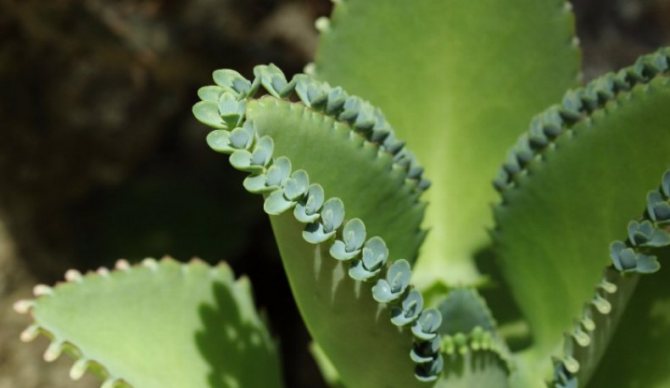

Kalanchoe luciae
This type of Kalanchoe is distinguished by large, very fleshy, crab-like leaves located in pairs on both sides of the stem. The lower leaves have a bright green-purple color, and the upper, green ones appear bluish due to the waxy coating that protects the fabric from the sun. The leaves, located almost vertically, give this Kalanchoe an original look, making the plant look like sea acorns or other molluscs fixed on stones.
The flowering of Kalanchoe luciae can be expected no earlier than two or three years after planting. An adult bush forms a powerful long peduncle covered with yellow flowers. Most often, after their withering, the plant dies, but it is easy to renew it with the help of children forming at the base of the outlet.
Short description
Kalanchoe Degremona (lat.Kalanchoe daigremontiana) naturally grows on the island of Madagascar, South Africa and America, as well as Asia, from where it came to Europe in 1925.
The plant belongs to the Tolstyankovye family, it has the main feature of all succulents - the ability to store water in fleshy tissues. A similar feature lies at the heart of the unpretentiousness of a green pet, which will do just fine without watering in the absence of the owner.
The plant grows a straight, thick stem and can reach a height of 60-100 cm. Green leaves acquire a bluish or grayish tint, while a scattering of small purple spots can always be seen on the underside.
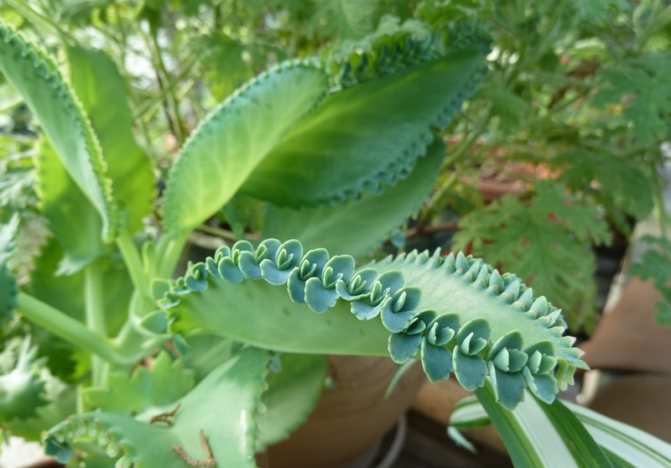

The shape of each individual leaf (not only in the photo, but also live) is triangular or pointed, and brood buds are located at the edges. It is from them that babies develop in the future, which are easy to use for reproduction at home.
Gradually, they form a stem, a couple of true leaves and their own aerial roots, and after falling into the ground, they quickly take root and grow well.
In most cases, Kalanchoe Degremona blooms in winter, when daylight hours begin to decrease. The plant produces a long stalk, decorated with a large inflorescence with red or pink buds.
What should be the temperature in the room
In order for the Kalanchoe Degremona, whose photo is given above, to grow well, certain rules for caring for it should be observed. Particular attention should be paid to temperature conditions. After all, this plant is tropical. In summer, the optimum temperature for Kalanchoe growth is about 27 ° C. In the cold season, this figure should not exceed 15 ° C. In winter, do not place the plant near heating appliances. Kalanchoe is not very fond of cold air. This can greatly deteriorate the leaves. If the temperature in the winter is kept very high, then the flower buds will simply not be laid.
Caring for the Kalanchoe Degremona at home
Kalanchoe Degremona is an unpretentious plant that has a unique ability to survive and reproduce. This flower is suitable for novice growers and will withstand any errors in care. However, it is still recommended to follow some rules that will help grow a strong and healthy succulent.
Requirements for soil and pot
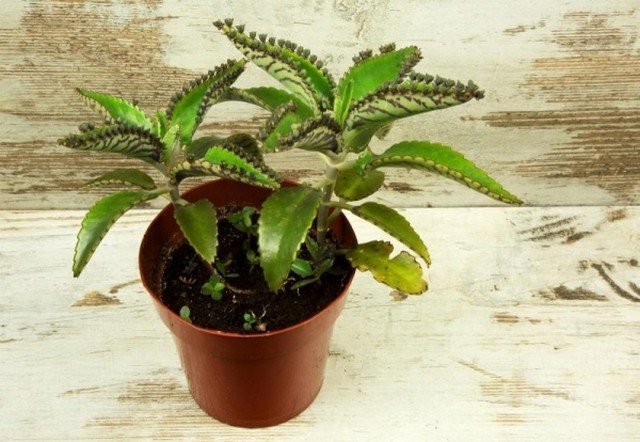

Like other representatives of succulents, the Degremona Kalanchoe does not need a spacious pot - too large a capacity will negatively affect its development. For transplanting, it is better to choose a flowerpot, the diameter of which is 2-3 cm larger than the size of the old one - this guarantees the health of the roots and will act as a kind of prevention of their decay in the event of soil flooding.
As for the substrate, it is preferable here to stay on a special soil for succulents or cacti, which is characterized by looseness, lightness and is not able to retain a lot of moisture.
You can prepare the soil for the Kalanchoe Degremon at home on your own. To do this, you need to mix several components in equal parts:
- Sod land;
- Overripe humus;
- Coarse sand;
- Crushed red brick or gravel chips.
Another scheme for compiling a substrate is also suitable:
- 2 parts of deciduous and sod land;
- 2 parts of peat;
- 3 parts perlite or coarse sand;
- A small amount of vermiculite.
There must be a drainage layer at the bottom of the pot, which will prevent stagnation of excess moisture. You can use not only expanded clay, but also "handy" materials - broken red brick or small pebbles.
Illumination and temperature conditions
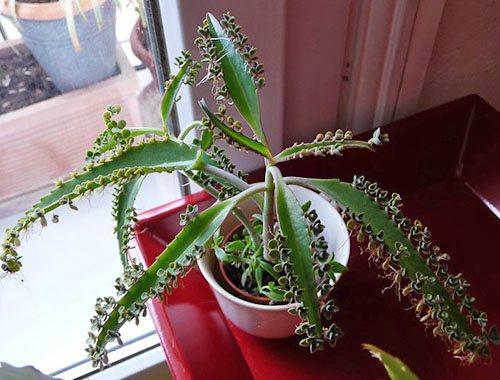

Kalanchoe Degremona is a light-loving plant that thrives on a strongly lit windowsill. The only caveat is that in the presence of direct sunlight, the flower will have to be shaded, since their prolonged exposure is fraught with the appearance of ugly burns on the leaves.
To stimulate the flowering of Kalanchoe, the duration of daylight hours is artificially reduced. The plant should be illuminated for no more than 8-10 hours, therefore, to create "night" conditions, the bush is taken out into a darkened room or covered with a paper cap.
The optimal temperature regime is considered:
- + 20- + 25 degrees in summer;
- The mark is +15 degrees in winter.
In the winter season, it is not recommended to place a pot of Kalanchoe Degremon next to heating devices, since the effect of dry air and high temperatures prevents it from growing properly. It will not withstand a succulent and drafts, so being near the window is also not desirable.
Watering and moisture
Degremona tolerates a lack of moisture well, but reacts negatively to abundant watering. It is necessary to moisten the soil when it dries out by 1-2 cm, and then in small portions. In summer, during a drought, water the Kalanchoe about 1 time in 7-10 days, guided by the state of the substrate and the flower itself.
In winter, you need to moisten the soil even less often, especially if the pot is in a cool room - overflow will invariably provoke the development of rot and fungi.
It is better to use room temperature water for watering at home for several days, while be sure to make sure that moisture does not get on the Degremon trunk. Watering can be overhead or in a pan, however, the dripped residues must always be drained.
This variety of Kalanchoe does not tolerate excessive air humidity, so you should not get carried away with spraying. If the leaves of the flower are dirty, gently wash them and soak up the remaining moisture so that they do not remain in the internodes.
Top dressing
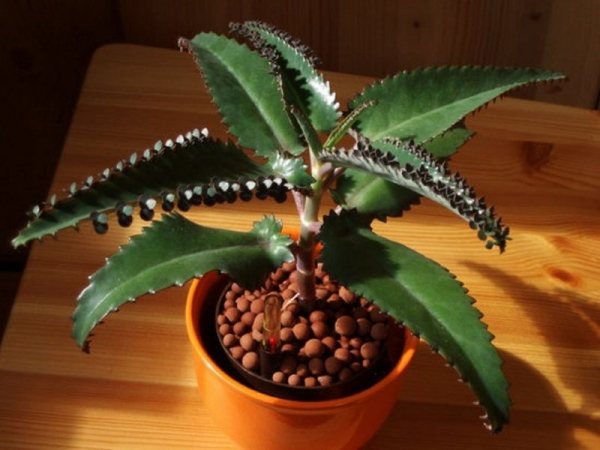

Kalanchoe Degremona is not demanding on fertilizers and does well without them, however, top dressing will not hurt. Replenishment with micro-, macroelements and other substances will help preserve the beauty of the foliage and the health of the flower as a whole.
It is advisable to feed Degremon once a month with compositions for cacti or succulents. If there is no opportunity to purchase special fertilizer, then universal complexes for indoor plants can also be used. In this case, it is recommended to reduce the concentration, making only half of the dosage indicated on the package.
In winter, Kalanchoe is not fertilized, but the spring-summer period is considered favorable for the introduction of additional "nutrition".
Read also: Darmera thyroid (peltiphyllum): planting and care in the open field
Fertilization and watering
Watering is required for every plant. In the summer, the soil should be moistened only when it dries well. It is necessary to water the Kalanchoe approximately once every 5 to 10 days. If excess moisture collects in the pallet, then it should be removed.This will avoid the formation of rot on the roots.
In terms of feeding, fertilizer should be applied every few weeks during vegetative growth. It is best to use formulations for cacti. In winter, Kalanchoe should be fed with fertilizer for flowering plants. In this case, the dose should be half.
Transplant features
Since the root system of Kalanche Degremon grows rapidly, the plant needs frequent transplants for normal growth and development. For young flowers (up to 5 years old), work is carried out annually, and adult specimens must be transferred to a new pot 1 time in 2-3 years.
It is imperative to transplant Kalanchoe in the spring, since during this period the plant adapts as quickly as possible to new conditions and takes root well. You need to be guided by the following rules:
- Pull the plant out of the pot carefully, being careful not to damage the fragile roots;
- In order for the root system to separate well, the walls of the pot can be moistened with water;
- It is better not to shake the earth from the roots - transplant the plant along with part of the old soil;
- There must be holes at the bottom of the pot to drain excess moisture and a drainage layer.
The transplantation scheme itself is quite simple: a small amount of the prepared substrate is poured onto the drainage layer, then the root system of the plant is placed. All free space is filled with soil, which can be lightly tamped.
Watering the Kalanchoe is carried out immediately during transplantation in order for the substrate to shrink in the pot. If necessary, the soil is filled up, and the plant itself is transferred to a place protected from direct sunlight. The adaptation of Degremon lasts about 1-2 weeks, and during this period the succulent is fully rooted in the pot.
Kalanchoe dissected (Kalanchoe laciniata)
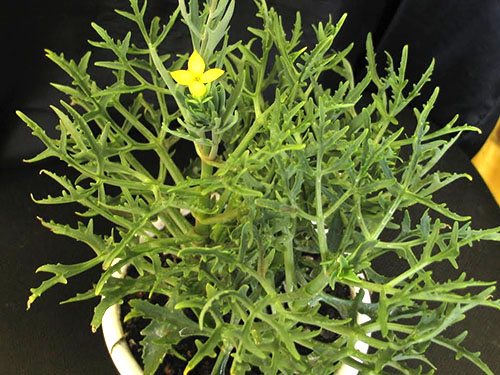

Kalanchoe dissected in nature is found in the subtropical regions of Africa. The plant is distinguished from other relatives by a deeply dissected, almost feathery form of juicy bright green leaves. Stems are erect, but with considerable length they can droop. To form a compact Kalanchoe bush, it is necessary to cut it off.
The flowers are profuse, yellow or orange flowers are simple, with four pointed petals.
Description of the plant
It is a herbaceous succulent plant that belongs to the Kalanchoe genus and the Tolstyankov family. This species came from the tropical zone to Europe. The Kalanchoe has a straight stem, which reaches a height of 100 cm, shiny, triangular, fleshy toothed leaves. Gray-green color of the leaves, strewn with purple spots on the back. Kalanchoe Degremon has flowering starts in winter, long-stemmed pink or red flowers bloom.
There are a lot of plant varieties, but the Degremon species has gained the widest popularity. The plant is popularly called by such names as indoor ginseng or Goethe flower. Kalanchoe is often called tree of life or the mother of a thousand, because the plant reproduces a large number of shoots in a short time, from which a full-fledged flower can be obtained.
Healing properties
Even official medicine takes advantage of the Degremon species. On the basis of the plant, specialists have created the Kalanchin preparation. The substance accelerates recovery from enterocolitis, gastritis, helps in the treatment of pressure ulcers, burns, frostbite and stops bleeding. Kalanchoe in its natural form has the following properties:
- anti-inflammatory;
- antimicrobial;
- wound healing;
- calming.
Kalanchoe juice effectively treats ARVI, runny nose and sinusitis. The use of the liquid outside is practiced for skin diseases and injuries, for the treatment of burns and wounds. Juice can be used to lubricate the mucous membrane on which ulcers have formed. An ointment based on petroleum jelly or lanolin is even better, because it does not cause itching and burning skin... Tincture of alcohol can be used orally as a prophylaxis for acute respiratory viral infections and influenza.
Application in traditional medicine
This family doctor cures many problems. Here is a list of the diseases that it eliminates:
Kalanchoe Blossfeld (Kalanchoe blossfeldiana)
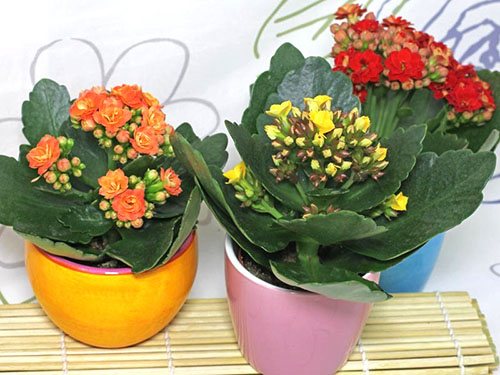

One of the most decorative species of Blossfeld's Kalanchoe, in the photo, is well known to amateur flower growers due to its lush flowering. In nature, this plant forms semi-shrub forms, consisting of erect, low-branched shoots with a height of 30 to 60 cm.
Related article: What are the differences between a garden equipped according to Meatlider?
The shape of the hairless, glossy leaves is ovoid. The leaf plate is dense, fleshy. The lower leaves are larger than those located closer to the top. The average length is about 4–6 cm.
Flowers of Kalanchoe Blossfeld, as in the photo, are collected in umbellate inflorescences. The flower diameter is 12–15 mm. In nature, there are mainly plants that form red flowers, but thanks to selection, flower growers have the opportunity to grow Kalanchoe of a wide variety of colors.
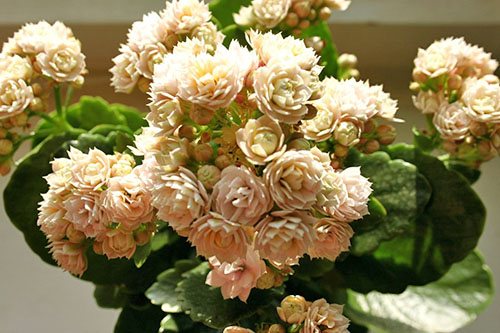

The most popular terry variety of Kalanchoe Blossfeld, in the photo, Kalandiva, delights with long flowering and lush inflorescences with white, yellow, orange, pink and scarlet buds.
Home care
Optimal soil
The soil should be chosen slightly acidic or neutral. A simple option is to buy ready-made succulent soil. It is light and loose, does not retain moisture. Why you can cook it yourself from the following ingredients:
- deciduous land;
- peat;
- vermiculite or drainage;
- sod land;
- perlite or coarse sand.
Watering the plant
The succulent plant does not like abundant watering and can withstand without water for two weeks. In the summer, the soil should be moistened if it has dried a centimeter. Plants are watered even less frequently in winter. In order not to rot the roots, you need to ensure looseness of soil and good drainage. Stagnant water can lead to root damage and the appearance of fungi and pests. In no case do not allow stagnant water in the pan.
Flower transplant
For growing, you can first pick up a stable and heavy pot of small size. Plants develop quickly enough, therefore, a transplant is required once a year until the age of 5 years. Older plants change their pot every 3 years. Early spring is the best time to transplant Kalanchoe. Transplant algorithm:
- Gently remove the plant from the pot, without shaking off the soil from the roots.
- Place the Kalanchoe in a large container, filling the voids with earth.
- Shake the pot lightly to compact the soil. Top up the soil.
- Apply fertilizer one week after transplanting.
Fertilizer and feeding
The plants should be fed every month with specialized fertilizers for succulents. If you have not seen these on sale, then take half the dose of top dressing for any plant. Apply fertilizer after removing dried buds so that Degremona will bloom next time. Take a break in the winter, at this time you should not feed old and young plants.
Diseases and pests
If Degremona does not bloom, this is a sign of improper care, parasite or mold infestation. Common pests:
- Shields. The leaves of the plant are covered with a grayish bloom, after which the fungus develops and nutrition is difficult. The mucus is removed with an alcohol solution.
- Aphid. Small insects densely cover the leaves, blocking the access of oxygen. If the leaves or stem are badly affected, cut them off. Treat the plants with laundry soap.
If leaves fall, then you need to feed the flower. If the plant turns yellow, the lighting should be improved. The absence of flowers in normal form indicates an excess of fertilizer. Dark spots are caused by excessive moisture and low temperatures. Drying of the plant is the result of a parasite damage to the roots or a lack of fluid.
Kalanchoe Porphyrocalyx (Kalanchoe Porphyrocalyx)
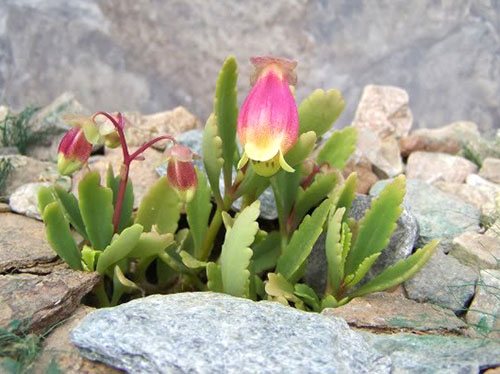

Among the Kalanchoe species growing in Madagascar, there are also true epiphytes, settling where it is difficult even to talk about the presence of some kind of fertile soil.Kalanchoe with amazing flowers in the form of bells of double color can perfectly feel mudflow both on tree trunks and on stone placers.
On bushes up to 30–35 cm high there is an abundance of light green elongated leaves. Flowering, unlike other Kalanchoe species, is short-lived and takes only two weeks.
Kalanchoe Gastonis-Bonnieri
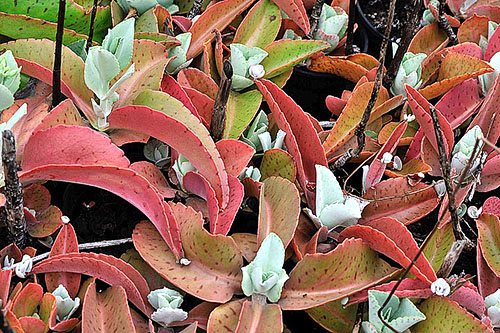

Another type of Kalanchoe from Madagascar, due to the shape of the elongated leaves folded along the longitudinal line, deserved comparison with donkey ears at home. The plant reaches a height of 50 cm. Young, silvery-green leaves are clearly visible against the background of the leaves of the lower tiers, painted in brown or reddish tones and covered with dark spots.
Kalanchoe blooms in winter, revealing bright yellow flowers on long brown peduncles.
Application in traditional medicine
Among scientists, there is a lot of controversy about the beneficial properties and toxicity of the plant, which are brought to the pages of the media and Internet resources. However, Kalanchoe Degremona juice has been used in folk recipes for more than one generation. Nevertheless, specialists should understand the expediency or harmfulness of oral administration, but for the external treatment of wounds and inflammatory ulcers on the skin with Kalanchoe juice, this remedy has no equal.
Freshly squeezed juice helps very well with lingering rhinitis. Diluted in half with boiled water and dripped 1 drop into each nostril, it causes frequent sneezing, during which the maxillary sinuses are remarkably cleared, and due to the anti-inflammatory effect, the runny nose quickly passes.
Many suffer from herpes sores that pop up at the slightest cold on the lips. Kalanchoe juice also copes well with them. Inflammatory processes on the skin of the face in adolescents, or the so-called youthful acne, are wiped overnight with a cotton swab dipped in juice. The problem goes away after several procedures.
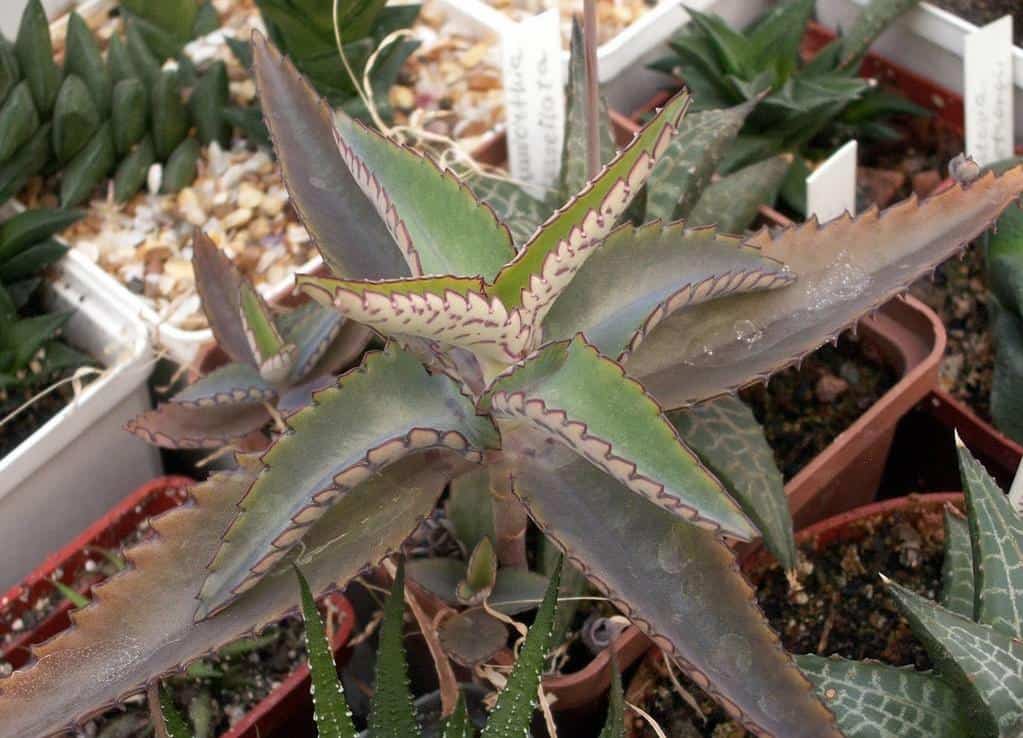

Kalanchoe Kalandiva
A marvelous species with a gorgeous name Kalandiva was born to a Swedish breeder. He noticed that flowers of an unusual purple hue appeared on the Blossfeld Kalanchoe bush. The appearance of a purple flower on a plant with a certain color scheme, which does not have purple shades in its set, is already an event, but the special admiration was caused by the fact that the shape of the flower was different.
The flower of the Kalanchoe Blossfeld, which makes up the cluster of the inflorescence, has 4 petals, and in this mutant the flower consisted of several petals, like a rose, the breeder counted as many as 32 petals. The inflorescence was beautiful, dense and resembled a ball, not a brush. These are the pirouettes Mother Nature gives to people who passionately love their work. The breeder looked forward to re-flowering to ensure that the traits of the new strain would reappear.
How wonderful that the breeding work does not stop, and now you can admire such beauty with beautiful names.
Pests seen on succulent
The presence of pests parasitizing on a flower is determined by the appearance of the plant. In warm apartments with dry air near Kalanchoe Degremon, yellowing and falling leaves are observed: the lower ones are possibly a natural aging process or lack of moisture, which is not too much needed in winter, when the plant is dormant, the upper ones are cause for concern, especially if they bend downwards, they turn brown and harden.
All these symptoms indicate that ticks have settled on the succulent, and after carefully examining the lower part of the leaf plates, they probably find a silvery cobweb. First aid to a flower is water procedures with a solution of laundry soap, and then it is necessary to determine the degree of damage and use either folk remedies or chemicals.
Aphids appear on succulents overfed with fertilizers and also hide from below on the leaves. Heavily bitten leaves are simply removed, the whole plant is sent under a warm soapy shower, and if necessary, treated with an insecticide.
Fluffy cotton swabs, upon closer examination, turn out to be a colony of mealybugs. This parasite is attracted by the rich nitrogen component of the soil mixture and is often accompanied by another nuisance - a sooty fungus. With small lesions of pests, they are picked by hand, however, it should be remembered that they multiply in the soil mixture, the nests are arranged secluded between the roots, and in order to get rid of them, it is necessary to spill the soil with an insecticide solution - actara, vermitic and others.
The shield is also removed by hand using a napkin moistened with alcohol, then washed in soapy water. An insecticide is treated if the lesions are extensive, with small amounts of the pest they cope with folk methods.
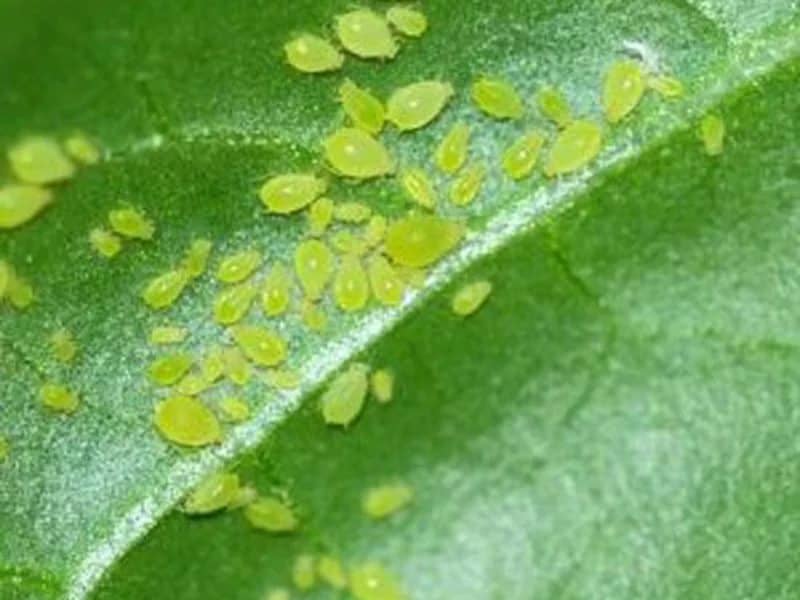

Where and how to plant?
Kalanchoe is one of the few flowers that will do almost all the work for a person. Reproduction usually occurs by both seeds and buds.
In the wild, Kalanchoe grows on sandy soils... To create similar conditions for growing this flower in a room, you should:
- Take loose soil and add an earthy mixture to it.
- To obtain an earthen mixture, it is necessary to mix components such as humus and leaf earth, sand.
- These ingredients must be mixed in a 1: 1: 1 ratio.
A small amount of peat and coarse sand will not hurt either.
Lighting and location
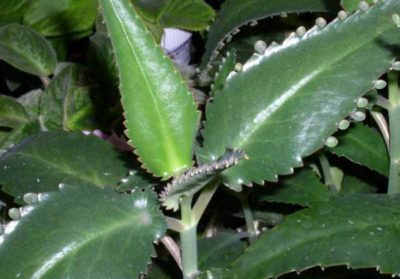

Kalanchoe degremona is an unpretentious plant, and if you choose a place in the room, then it should be at least slightly illuminated by sunlight. With abundant light, the color of the leaves may change slightly in the flower, they will turn red.
In ideal conditions for Kalanchoe, the western and eastern sides will be the best. Additional lighting is desirable in winter.
In the absence of sufficient light, the plant weakens and the lower leaves may fall off.
Leaves may turn brown or black spots due to high humidity.... It also depends on the temperature, if the temperature is very low, then the flower can get sick.
Despite the fact that Kalanchoe has an interesting property - to store the accumulated moisture in the leaves, it should be watered, but in each period in different ways. From March to October, watering should be moderate, and the soil should not be too wet before the next watering, as an excess of moisture affects the plant destructively. In winter, the frequency of watering can be reduced.
Kalanchoe dwarf Pumila (Kalanchoe Pumila)
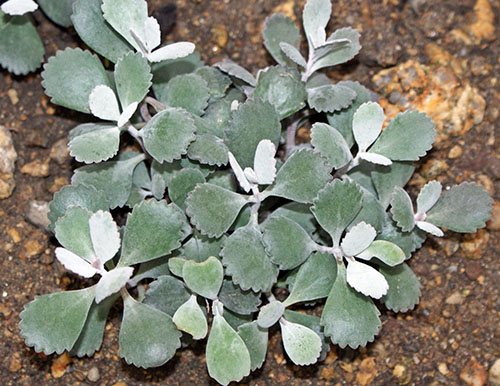

The Pumila species from the central regions of Madagascar is a dwarf among other Kalanchoe species. The height of the graceful shrub is only 20 cm. The shoots, which at first remain upright, sag as they grow.
The fan-shaped leaves with a wavy edge at a young age have a dark green color and are covered with a gray waxy bloom, but later become purple or brown.
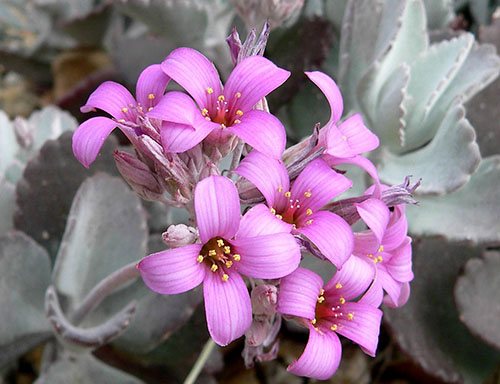

Flowers, bright against the background of grayish foliage, are collected in small paniculate inflorescences and stand out with a violet-pink color and beautifully curved petals.
Diseases
Despite the plant's vulnerability, it is still susceptible to some diseases.
- One of the most unpleasant diseases for Kalanchoe is late blight or late blight rot... Usually, ugly brown spots or brown bloom appear on the leaves of the plant. Poor ventilation or too much water in the soil may be the cause.
- Powdery mildew also did not bypass the Kalanchoe. White spots form on the leaves of the plant, after which a fungal bloom appears. This disease occurs due to excessively dry air, then the Kalanchoe begins to shed its leaves. If such a plaque has formed, it is necessary to move the flower to a sufficiently cool place.
- Another Kalanchoe disease - gray rot... Signs of this disease appear in the form of weeping gray spots, and if you do not take action, they grow and turn into porridge. When a flower freezes, black spots usually form on the stem.In winter, the temperature should not be lower than fifteen degrees, otherwise the flower may get sick.
Contraindications to use
All preparations, even if they are herbal, should be used after consulting a doctor, so as not to harm the body and health in general. Kalanchoe Degremona has its own contraindications for individual intolerance and allergic reactions. You should not use the plant during pregnancy, with low pressure, with tumors. Also, you can not use Kalanchoe for liver diseases, hepatitis.
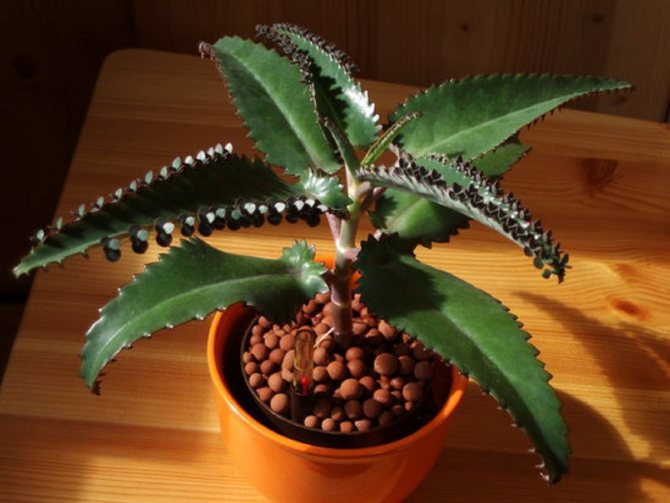

Home page "Kalanchoe Degremona - indoor" ginseng "
Kalanchoe Degremona is perhaps the most common medicinal houseplant. Perhaps every person knows about its medicinal properties. A plant with large, long leaves, hung with "children" - brood buds, grows in almost every house (or once grew). This feature is the hallmark of the plant. Because of them, this type of Kalanchoe is called viviparous.
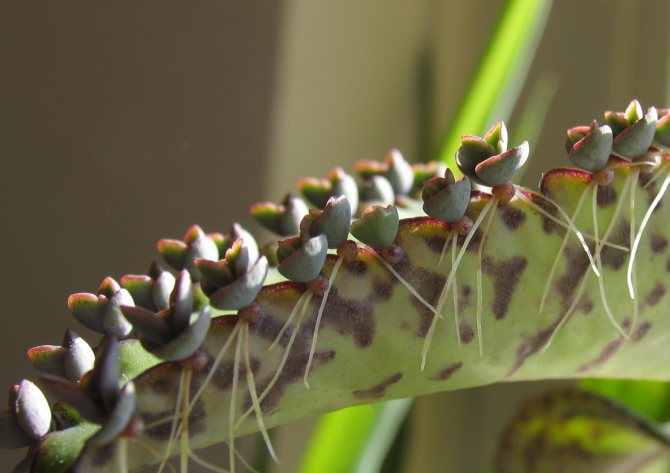

In Europe, the Kalanchoe Degremona has been cultivated since 1925. It appeared in our country a little later, but became more widespread in home floriculture than in European countries. To this day, this medicinal plant can be found on almost every windowsill.
Kalanchoe laxiflora (Kalanchoe laxiflora)
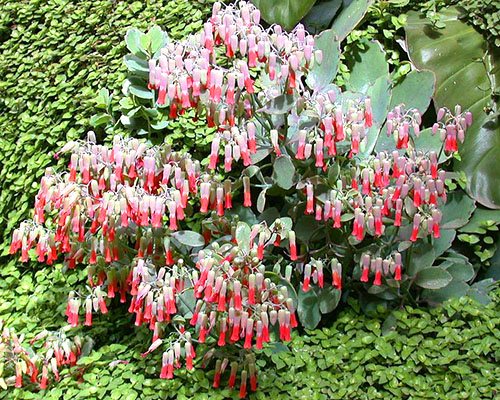

The loose Kalanchoe is an indigenous inhabitant of the rocky humid regions of Madagascar, where plant shoots, up to 50 cm long, easily climb rather steep ledges and stones. Leaves are bluish green, usually with a reddish border around the edge. Sometimes there are varieties with brown or reddish foliage. The plant resembles the Mangin Kalanchoe, but is larger and more powerful.
Ovate leaf blades do not exceed 6 cm in length. The edges of the leaves are rounded-toothed. Peduncles reach a length of 50 cm, and the ones hanging on them consist of a green tube and a red, lilac, orange or violet-pink corolla 10 to 20 mm long.
Reproduction
There are several breeding methods Degremon.
First - shoots from the tops of the leaves. In the spring, ready-made shoots with roots fall off by themselves. They must be selected and planted in separate pots with peat and sand. Cover the container with foil and make small holes for ventilation.
Sprouts put under diffused light. After the shoots take root and the first leaves appear, you should remove the film and pinch the crown. Sprinkle the earth periodically.
Second breeding method - seeds. They are sown at the end of winter in sand and leafy soil. Keep the temperature in the region of 20-22⁰С.
In the second week, the seeds begin to germinate, they should be picked, and then put the pot in sunlight.
How to propagate
Like most indoor plants, reproduction in the Kalanchoe Degremon occurs mainly by cuttings. But this culture is amazing in that it also reproduces by children.
Reproduction by children
Babies are brood buds at the tops of leaves. In the spring, ready-made children with roots disappear by themselves. They need to be selected and planted in separate containers with peat and sand, covered with foil and made small holes for ventilation. When the shoots take root, plant them and place them in a bright, diffused light. When three pairs of leaves appear on the stalks of young Kalanchoe, you need to pin the top of the head.
Cuttings
Another fairly easy way to propagate a succulent is cuttings. There are two types of cuttings: instrumental and manual.
The instrumental method of grafting at home is carried out using a sharp knife or blade. In this case, it is necessary to cut the top of a healthy stem of the plant.
When carrying out cuttings by hand, you just need to carefully separate the lateral shoot in the leaf axil with your fingers.
In the event that the cuttings already contain air roots, their rooting will happen very quickly and easily. They can be planted immediately in a permanent pot.
If there are no air roots, it is necessary to remove the lower leaves of the cutting and leave the cut site to dry for about a day. Then the appendage should be placed in a temporary container with moist peat.
Propagation by axillary buds
If no children are formed on the leaves of the Kalanchoe, then axillary buds appear at the point of attachment to the leaf trunk. You can wait for the axillary bud to form and fall into the ground by itself. Then it can simply be transplanted according to the principle of transplanting children. You can also cut off the kidney with a sharp knife, as soon as its stem increases in size by about a centimeter, and plant it in the ground.
Propagation by leaves
This type of reproduction is convenient because it can be used at any time of the year. Kalanchoe reproduces very easily with the help of a leaf plate, one has only to cut off a healthy leaf and dig it into the ground. Be sure to cover the top with a jar or glass to create a favorable environment for the future succulent. Soon a young plant will form from the leaf.
Fallen leaves can also be used for propagation. You just need to briefly immerse them in water for the appearance of roots, and then plant them in the ground. As simple as from a leaf, you can grow a Kalanchoe from a shoot.
Kalanchoe blooming
As you can imagine, medicinal Kalanchoe species, even flowering ones, do not have particularly decorative properties. But a blooming decorative look will bring beauty and positive energy to the house. Plants bloom for a long time under appropriate care conditions. The flowering period and duration can be adjusted by light conditions. Flowering varieties are sensitive to the length of daylight hours. As a rule, they buy a flowering plant in the store, in which the flowering mode is adjusted by the artificial lighting mode.
Useful video
A little more useful information about the medicinal plant Kalanchoe and its species, you will learn from a short video:
If you find an error, please select a piece of text and press Ctrl + Enter.
On the World Wide Web, there is a lot of information about the amazing Kalanchoe plant, however, there is confusion about the Kalanchoe species that have a healing effect. Not all sites will give you detailed and reliable recommendations, so this article will fully disclose the problem, relying on authoritative sources.

